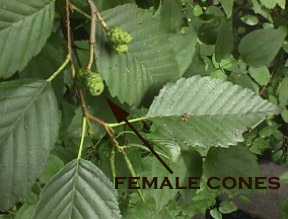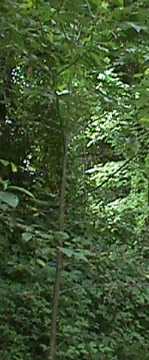

General Species Description
- Red Alder grows from seeds or by sprouting from stummps, often times as a pioneer species in newly disturbed wetlandd areas and livinng up to 50 years. Alnus rubra grows to be 25-30m in drier condiiitions and lesser in saturated soils. The bark is thin, grey, and smooth, often occurring with white patches of lichen. Short stalks with club-shaped buds present. The leaves are decciduous and 5-15cm long and are half as wide. The male catkins can occur as early as November, before maturity and will create a redish glow on hillsides during Feb.-March. The inner bark and wood will apear a rusty-red color when cut.
Leaves
- The leaves aree alternate, 5-15cm long and half as wide,oval in sshape, heavily vveined, dull green and smooth above, rust-coloured and hairy below, wavy margins that are slightly rolled under, and singled-toothed.
Inflorescence/Flowers
- Male and female flowers are in hanging cylindrical spikes containing catkins, which appear before the leaves and stay through winter. They appear green when young, turning deep brown when mature and woody in texture.
Fruits
- The fruits are in brownish clusters of cones approximately 2cm long; containing oval, winged nutlets, that remain on the tree through winter.
Habitat
- Very common below 300m in the Pacific North West and occurring in the west side of the Cascade Mountains, where precipitation is high and may saturate the soil for short periods of time. Can be present in either wetland or nonwetland areas. Red Alder is salt-intolerant and shade-intolerant. Also found in newely cut areas, flood plains, along streambanks and in moist woods. Occurring with understory associates such as salmonberry (Rubus spectabilis), lady fern (Athyrium filix-femina), and skunk cabage (Lysichiton americanum).
Range
- Alnus rubra is found on the westside of the Cascades and Coastal Mountains, from S. Alaska to N. California. Also present in all counties in north west Oregon and south west Washington.
Similar Species
- Slide alder is similar exept it is a multistemed shrub and leaf margins are not turned under with winter buds pointed sharply. The hazelnut (Corylus cornuta) is similar but the hazelnut leaves are rounder, irregular shaped, lighter green leaf tips are hairy; with the male catkin being longer and thinner. Rhamnus purshiana bark and leaves are similar, but the trunks are narrow, spindly, rarely containing lichen patches, the leaf maargins have smooth-margins and rounded at the tips.
Ecological Value
- This tree provides shade to streams, habitat for birds and insects.
Human Value
- Red alder contains nitrogen-fixing bacteria that enriches the soil, which can help in reducing fertilizer use to second growth forests. Alder suppresses the growth of conifers and is an important component of extensive flood plain wetlands. The alder also provides organic buildup on the forest floor from leaf litter and houses cavity nesters and small cavity-dwelling birds and other mammals. Common human uses include firewood, heat for smoking salmon and other meat and is used as a choice hardwood for furnature.
References
- Cooke,S.S.,ed. 1997. A Field Guide to the Common Wetland Plants of Western Washington and Northwestern Oregon. Seattle Audobon Society and Washington Native Plant Society. Seattle Audobon Society, Seattle WA, 417pp. Pojar and Mackinnon. Plants of the Pacific Northwest Coast. Redmond,WA: Lone Pine Publishing,1994.
This page was created by: Chad Smith, August 1998
Return to Northwestern Oregon Wetland Plants Project